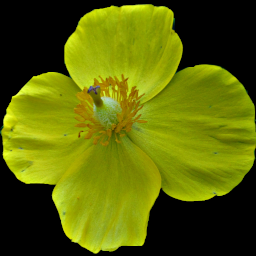This tiny prostrate weed is a close relative of the colorful Moss Roses we grow in gardens—the thick, fleshy red stems and succulent leaves show the relationship clearly. The little yellow flowers open only in the morning, and only in bright sunlight; we shaded the plants momentarily to take these pictures at midday without the harsh glare. Purslanes can grow almost anywhere they get a foothold, and can survive being pulled up and thrown away to root elsewhere. In the city they are very common crack-in-the-sidewalk weeds. The plant above was growing from a crack on the top of a low concrete wall; the one below (magnified many times—the boulders in the picture are ordinary gravel) was growing in a gravel parking lot. Both were a little west of Cranberry, blooming in early September. Purslane was once commonly used as a salad green, valued for its texture rather than its famously bland taste.
We are experimenting with a camera we bought used for $20 that claims to be able to focus as close as an inch from the subject. So far, we are pleased with the results.
Gray describes the genus and the species:
PORTULACA [Tourn.] L. PURSLANE. Calyx 2-cleft; the tube cohering with the ovary below. Petals 5, rarely 6, inserted on the calyx with the 7-20 stamens, fugacious. Style mostly 3-8-parted. Pod 1-celled, globular, many-seeded, opening transversely, the upper part (with the upper part of the calyx) separating as a lid. — Fleshy annuals, with mostly scattered leaves. (An old Latin name, of unknown meaning.)
P. olerácea L. (COMMON P.) Prostrate, very smooth; leaves obovate or wedge-form ; flowers sessile (opening only in sunny mornings); sepals keeled; petals pale yellow; stamens 7-12 ; style deeply 5-6-parted; flower-bud flat and acute. — Cultivated and waste grounds; common.—Seemingly indigenous westw. and southwestw. (Nat. from Eu.)








